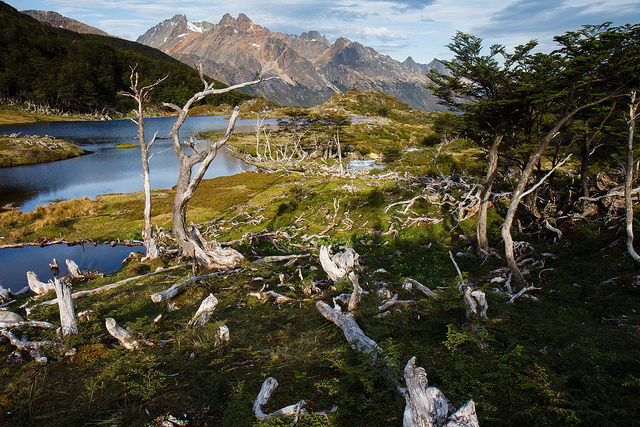If Patagonia is exciting, the archipelago of Tierra del Fuego (Land of Fire) is electrifying. In days of sail, the reputation of its sub-Antarctic weather and ferocious westerlies obsessed sailors whether or not they had ever experienced the thrill—or terror— of “rounding the Horn.” After surviving the southern seas en route to California in November 1834, Richard Henry Dana vividly recounted conditions that could change from calm to chaos in an instant:
“Here comes Cape Horn!” said the chief mate; and we had hardly time to haul down and clew up, before it was upon us. In a few moments, a heavier sea was raised than I had ever seen before, and the little brig plunged into it, and all the forward part of her was under water; the sea pouring in through the bow ports and hawse-hole, and over the knight-heads, threatening to wash everything overboard. At the same time sleet and hail were driving with all fury against us.”

A beach in Tierra del Fuego, Argentina. Photo © Indrik Myneur, licensed Creative Commons Attribution.
In Dana’s time, that was the price of admission to one of the earth’s most spectacular combinations of sea, sky, land, and ice. In a landscape whose granite pinnacles jut nearly 2,000 meters out of the ocean, only a handful of hunter-gatherers foraging in the fjords and forests could know the area with any intimacy. Today, fortunately, there are ways to reach Tierra del Fuego that involve less hardship, not to mention motion sickness, than Dana and his shipmates suffered.
Two ferry routes connect the Chilean mainland to Tierra del Fuego: a shuttle from Punta Delgada, only 45 kilometers south of Argentina’s Santa Cruz Province, across the Primera Angostura narrows to Puerto Espora; and a daily service from Punta Arenas to Porvenir, one of the widest parts of the strait.In his memoirs, pioneer settler Lucas Bridges labeled Tierra del Fuego the “uttermost part of the earth” for its splendid isolation at the continent’s southern tip. It’s still a place where fur seals, sea lions, and penguins cavort in the choppy seas of the strait named for celebrated navigator Ferdinand Magellan, where Darwin sailed on the Beagle and the first 49ers found their route to California. From the seashore, behind its capital of Ushuaia, glacial horns rise like sacred steeples. The beaches and southern beech woodlands of Parque Nacional Tierra del Fuego, west of the city, are the terminus of the world’s southernmost highway.Tierra del Fuego is not just one island, but an archipelago, though the Isla Grande de Tierra del Fuego is South America’s largest island. Chile shares the territory with Argentina. While parts of the Argentine side are urbanized, the Chilean side has just a few small towns and isolated ranches. Roads are few but improving, and some are now paved, especially on the Argentine side. The unpaved roads can be hell on windshields, which are most cheaply replaced in the Chilean mainland city of Punta Arenas.
Two ferry routes connect the Chilean mainland to Tierra del Fuego: a shuttle from Punta Delgada, only 45 kilometers south of Argentina’s Santa Cruz province, across the Primera Angostura narrows to Puerto Espora, and a daily service from Punta Arenas to Porvenir, over one of the widest parts of the strait.
Like the rest of southern South America, Tierra del Fuego deserves all possible time, but most visitors have to make choices. Ushuaia is the best base for sightseeing in Tierra del Fuego proper, given its access for excursions to the nearby national park, the Beagle Channel, and Estancia Harberton, with a minimum of three days. Hikers may wish to spend several days more and fly-fishing aficionados, who often prefer the vicinity of Río Grande, can easily stay a week or two.
Excerpted from the Fourth Edition of Moon Patagonia.